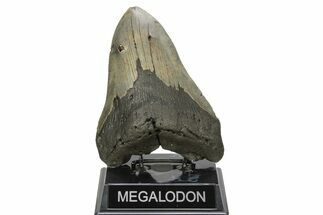This Specimen has been sold.
.91" Fossil Shark Tooth (Hemipristis) From Angola - Unusual Location
This is a .91" fossil Hemipristis tooth collected from a unique and rare locality in the Cuanza Sul (Kwanza-Sul) Province of Angola, Africa. It comes from the Luanda Formations, making it Late Miocene in age. This material was collected by a geologist working in the country about 15 years ago, so there are almost no Angola shark teeth out there.
Comes with an acrylic display case.
Comes with an acrylic display case.
About Hemipristis
Hemipristis teeth are some of the most beautiful and horrifying dentition in the entire shark world. Hemipristis, known as the snaggletooth sharks, belong to a genus of weasel sharks. The genus Hemipristis contains one surviving species and several extinct species.
Hemipristis uses its morbid grin as an instrument of death. It hooks and slices prey using two distinct types of teeth in each section of its jaw. The broad, triangular teeth on the upper jaw act as serrated knives, cutting through the flesh of the prey. The pointed ones on the bottom act like forks, spearing the prey and holding it down. They have very long, strongly hooked cusps and protrude when the mouth is closed.
Giant snaggletooth sharks that terrorized the Atlantic Ocean during the Tertiary were considerably larger than their modern relatives. Marks made by the teeth of H. serra are often found on the bones of the manatee Metaxytherium, suggesting that H. serra had an affinity for sirenians (Sea Cows). Today's remaining species, H. elongata, is considerably smaller and mainly feeds on smaller fishes, rays, crabs, and cephalopods.
Hemipristis curvatus is an extinct species which existed during the Eocene (55.8-33.8 mya). It was followed by Hemipristis serra, which lived through the Oligocene-Miocene (33.9-5.2 mya) of Florida, South Carolina, and other areas on the Atlantic coast. Hemispristis preferred warm water. As the temperature of the oceans cooled with the approach of the Pliocene, Hemispristis retreated from northern latitudes before going extinct.
Hemipristis teeth are coveted for their exotic shape and beautiful color. Teeth from the Atlantic coast along the American South are especially prized.
Hemipristis teeth are some of the most beautiful and horrifying dentition in the entire shark world. Hemipristis, known as the snaggletooth sharks, belong to a genus of weasel sharks. The genus Hemipristis contains one surviving species and several extinct species.
Hemipristis uses its morbid grin as an instrument of death. It hooks and slices prey using two distinct types of teeth in each section of its jaw. The broad, triangular teeth on the upper jaw act as serrated knives, cutting through the flesh of the prey. The pointed ones on the bottom act like forks, spearing the prey and holding it down. They have very long, strongly hooked cusps and protrude when the mouth is closed.
Giant snaggletooth sharks that terrorized the Atlantic Ocean during the Tertiary were considerably larger than their modern relatives. Marks made by the teeth of H. serra are often found on the bones of the manatee Metaxytherium, suggesting that H. serra had an affinity for sirenians (Sea Cows). Today's remaining species, H. elongata, is considerably smaller and mainly feeds on smaller fishes, rays, crabs, and cephalopods.
Hemipristis curvatus is an extinct species which existed during the Eocene (55.8-33.8 mya). It was followed by Hemipristis serra, which lived through the Oligocene-Miocene (33.9-5.2 mya) of Florida, South Carolina, and other areas on the Atlantic coast. Hemispristis preferred warm water. As the temperature of the oceans cooled with the approach of the Pliocene, Hemispristis retreated from northern latitudes before going extinct.
Hemipristis teeth are coveted for their exotic shape and beautiful color. Teeth from the Atlantic coast along the American South are especially prized.
SPECIES
Hemipristis sp.
AGE
LOCATION
Cuanza Sul (Kwanza-Sul) Province, Angola, Africa
FORMATION
Luanda Formation
SIZE
.91" long
CATEGORY
SUB CATEGORY
ITEM
#259443
We guarantee the authenticity of all of our specimens.
 Reviews
Reviews












